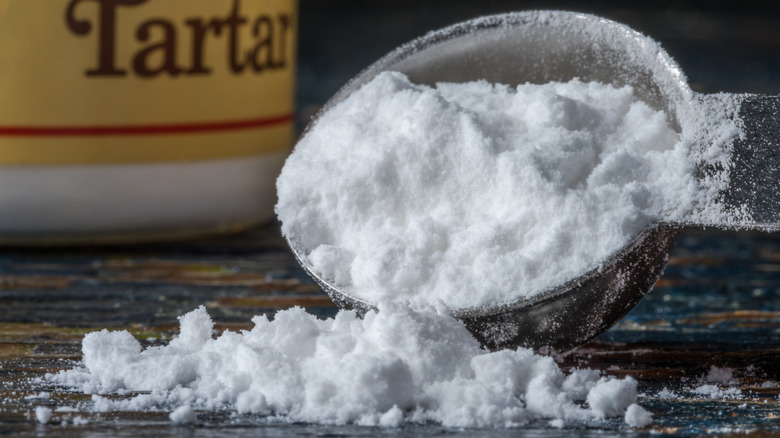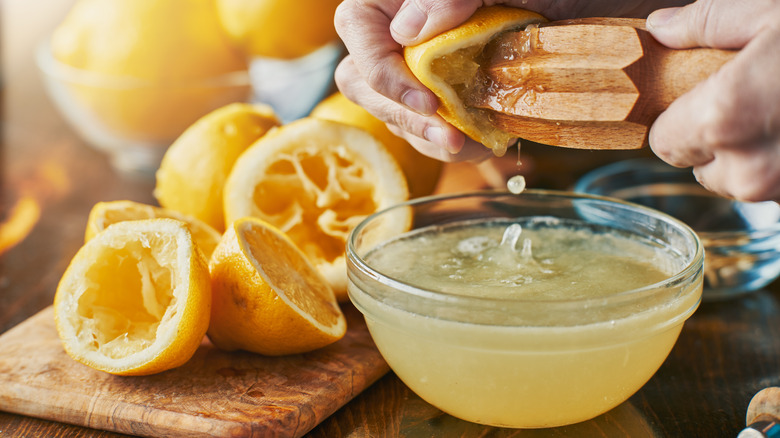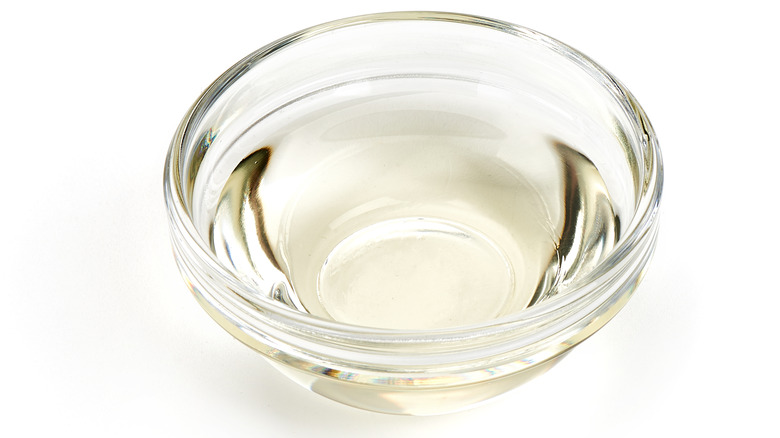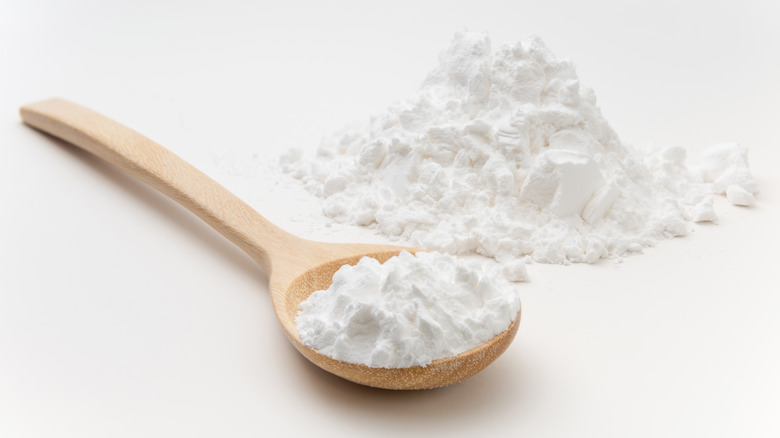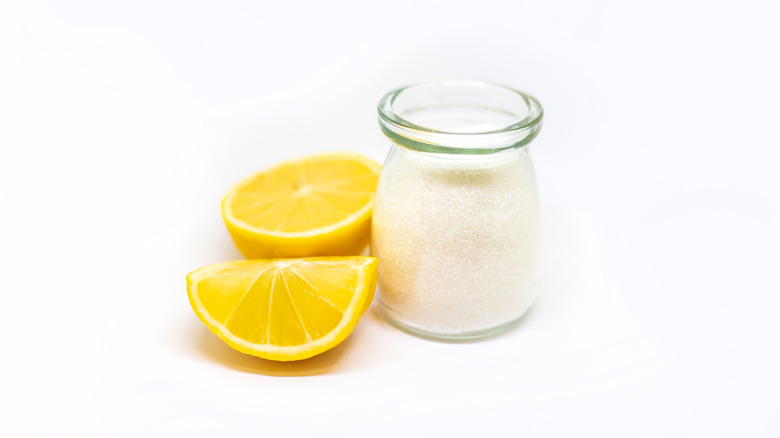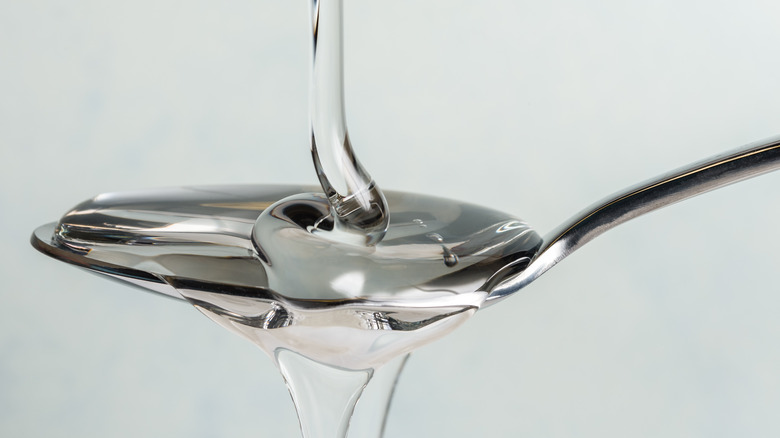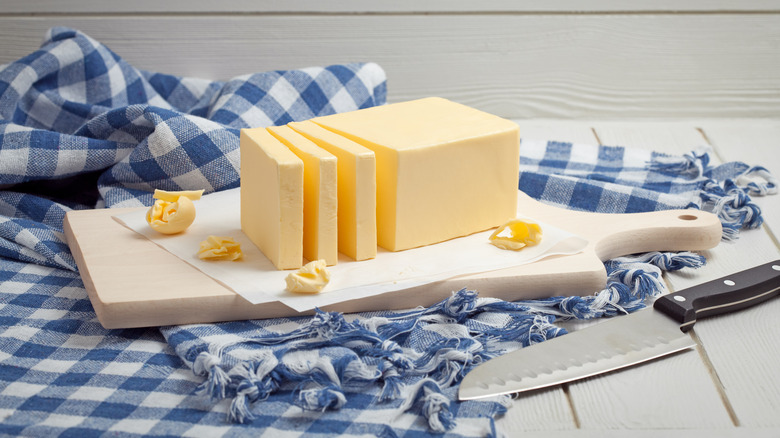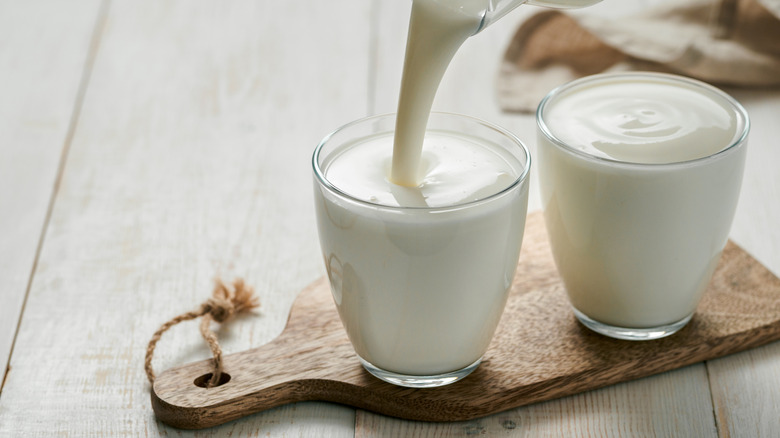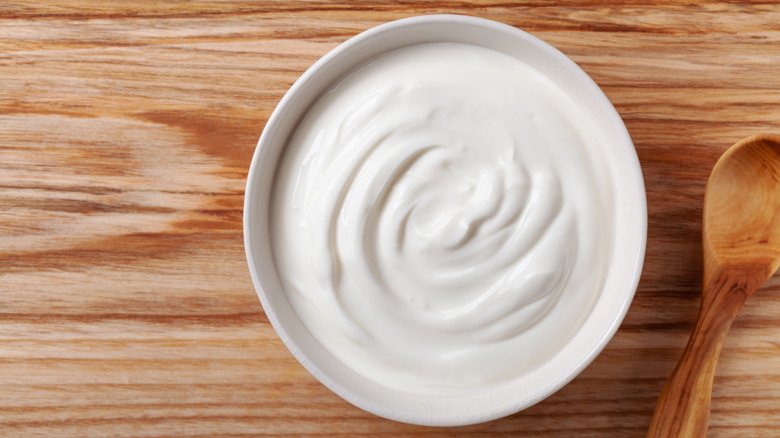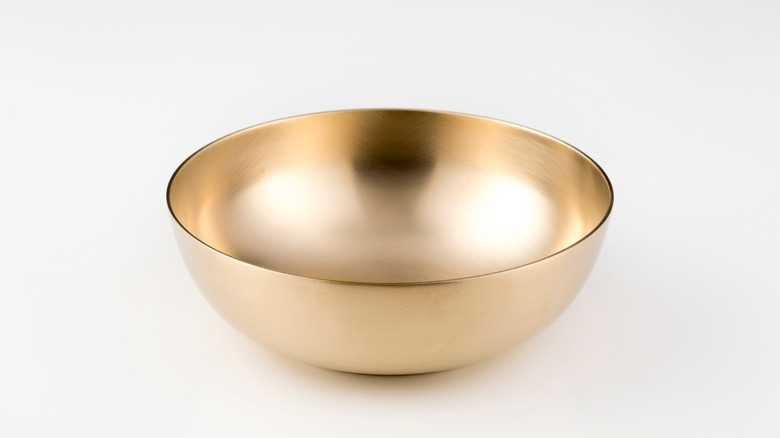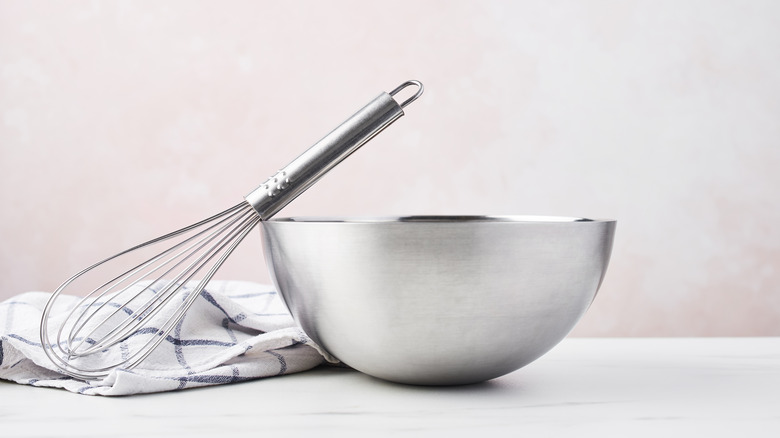10 Best Substitutes For Cream Of Tartar
Cream of tartar can stabilize a weepy meringue, it adds fluffiness to buttermilk pancakes, and it even makes cookies extra soft. Thanks to its leavening properties, just a pinch of the stuff can take pretty much any baked good to the next level, and if you tend to be heavy-handed with a whisk, it can easily save you from overworking your batter or dough (via Food52). Omit it from a recipe, however, and the resulting dessert could literally fall flat. After all, it is one of the main components of baking powder.
Despite being the unsung hero of so many desserts, cream of tartar (or potassium acid tartrate) isn't exactly a pantry staple. Unless you're a pastry chef or professional baker, chances are you don't have it on hand all the time. If your recipe calls for cream of tartar but it's the one thing missing from your kitchen, fortunately, there are plenty of viable substitutes. Whether you need cream of tartar for leavening or for stabilizing, these 10 substitutions have you covered so there's no need to rush out to the store or save the recipe for another day.
1. Lemon juice
According to Food Network, the closest substitution for cream of tartar is lemon juice. Cream of tartar is a powdered form of tartaric acid, and lemon juice shares the same acidic properties.
If you're worried about your dessert becoming too sour, lemon juice is no more sour than cream of tartar. Spiceography explains that cream of tartar literally gets its name from its tart acidity. If you accidentally add too much cream of tartar, the only way to combat the sourness is to add sugar, so it's actually easier to work with lemon juice because it already contains natural sugar. Lemon can help stabilize egg whites and prevent crystallization in syrups.
While cream of tartar is twice as strong as lemon juice, for any recipe that calls for cream of tartar, you can easily use lemon juice instead. The substitution ratio is a simple 1:2, so just use double the amount of lemon juice, and follow the rest of the recipe as-is. There's no need to accommodate for the extra liquid since most recipes only call for a pinch of cream of tartar anyway.
2. White vinegar
White vinegar and cream of tartar function so similarly that the substitution ratio is 1:1. In terms of flavor, however, the white vinegar isn't such an even swap. While it is just as powerful an acid as cream of tartar, it also has a powerful flavor that can easily mess up the intended taste of a dessert. Therefore, for recipes that rely primarily on one flavor, like vanilla or powdered sugar, white vinegar isn't the best cream of tartar substitution. However, for recipes that require whipping egg whites into a meringue, cream of tartar and white vinegar are practically interchangeable, because both ingredients stabilize the air bubbles that are essential to the texture (via Cook's Illustrated).
Make sure you use white vinegar, and not white wine vinegar, because white wine vinegar is made from white wine, while white vinegar is made from acetic acid. The white vinegar substitution works because cream of tartar is an acid too.
You can substitute an equal amount of white vinegar for cream of tartar in your recipe.
3. Baking powder
Perhaps the most obvious substitution for cream of tartar is baking powder. Per BBC Good Food, baking powder is a combination of cream of tartar and baking soda — two parts cream of tartar and one part baking soda. This might seem like a foolproof substitution, but baking soda has its own set of chemical reactions, and although baking powder, baking soda, and cream of tartar are all white powders with leavening properties, the proportions do make a difference.
Substituting baking powder for cream of tartar won't work in every single recipe, but it does work like a charm for ones that call for both baking soda and cream of tartar. One teaspoon of baking powder is equivalent to exactly ⅔ teaspoon of cream of tartar and ⅓ teaspoon of baking soda, however, if these measurements are hard to adjust for your recipe, use 1 ½ teaspoons of baking powder for every one teaspoon of cream of tartar.
4. Citric acid
The soufflé is one of the most technically challenging desserts, and its signature height is only made possible because of egg whites and cream of tartar. Considering the recipe is notoriously hard to master, substituting any of its ingredients is normally a risky game, but eHow confirmed there's one exception. When it comes to cream of tartar, citric acid works just as well. The reason, the article explained, is that "Soufflé gets its rise from the air trapped by coagulated egg proteins." Citric acid coagulates the egg proteins in the same way cream of tartar does, so for a soufflé, it's the best alternative ingredient if you don't have any cream of tartar to spare. If you don't have either of the two ingredients, unfortunately, you're out of luck, as a soufflé relies on such a specific combination of chemical reactions that any other cream of tartar substitute, like corn syrup, for example, won't cut it.
You can substitute an equal amount of citric acid for cream of tartar in your recipe.
5. Corn syrup
Adding cream of tartar to cookie dough makes the softest batches, and it's all thanks to the crystallization inhibitors in the cream of tartar (via The Bearfoot Baker). When you take your cookies out of the oven, the dissolved sugar cools, and when it cools, it also hardens, or crystalizes. This is what gives cookies their crunch. Cream of tartar disrupts this crystallization because as an acid, it breaks down sugar into glucose and fructose, according to Science of Cooking. Corn syrup has already turned into glucose, so it's basically the product of a cream of tartar and sugar reaction. Since corn syrup doesn't crystallize in the same way that sugar would in a cookie, adding cream of tartar would be an unnecessary step.
You can skip the cream of tartar altogether if you replace all or some of the sugar in your recipe with corn syrup, depending on how soft you want your cookies.
6. Butter
It can pretty much go unsaid that everything tastes better with butter, and when you add extra to cookies, it can even replace cream of tartar, Food52 says. The whole point of adding cream of tartar to cookies is to give them a softer texture, and though both butter and cream of tartar effectively achieve this in different ways, the end result is just as delicious. While cream of tartar makes cookies soft by breaking down the sugar into glucose and fructose, butter does so by way of its fat molecules, which disrupt the sucrose crystals from forming.
Substituting cream of tartar for butter doesn't require exact measurement and the substitution ratio isn't a perfect 1:1 either, so you may have to play around with your cookie dough until it looks and tastes right. Ultimately it all depends on how soft you like your cookies. Butter can make cookies chewy and greasy too, so make sure to take into consideration all of butter's properties before you opt for this cream of tartar substitution.
7. Buttermilk
If your main goal is to make your cakes fluffier and softer, you can't go wrong with buttermilk. Because buttermilk is acidic, it helps achieve a lighter, more airy texture in the same way cream of tartar does. Due to the fact that it's a heavy liquid, it doesn't work nearly as well when used as a stabilizer in a meringue or egg white-based dessert, but for anything cakey, you won't even need cream of tartar.
Pay close attention to the proportions of the other ingredients in your recipe, because adding buttermilk will definitely alter the consistency of your batter. Just a pinch of cream of tartar (¼ teaspoon to be exact) is equivalent to ½ cup of buttermilk, which means you'll have to remove an entire ½ cup of liquid from the original recipe, per The Pioneer Woman blog. Buttermilk is definitely a great substitution for cream of tartar in cake batter, but for cookie dough or really anything else, go with a different substitution.
8. Yogurt
Yogurt is a viable substitution for cream of tartar in cake recipes, but because of its thick consistency, incorporating it into the batter is a two-step process. First, it must be gradually diluted with milk until it becomes the consistency of buttermilk. Then, before adding it into the batter, ½ cup of liquid from the original recipe must be removed. Though it seems counterproductive to add one liquid only to remove another right after, it's all a matter of getting the proportion of the acid content right relative to the other ingredients. Cream of tartar is pure acid, but yogurt of course is not, and as they say, baking is an exact science. The acidity of yogurt is most similar to the acidity of buttermilk, so the way it's used as a cream of tartar substitute is similar to the way buttermilk is used. Save this substitution only for baked goods, as it's not very convenient.
According to Blog Chef, use ½ cup diluted yogurt to substitute for ¼ tsp of cream of tartar. Be sure to remove ½ cup liquid from the rest of the recipe.
9. Copper mixing bowl
It's hard to believe that the material of the mixing bowl could play a role in the outcome of your recipe, but according to Food52, there's a science as well as a history behind it. A copper bowl can replace cream of tartar altogether, and the French have been doing it for centuries. Author of "On Food and Cooking" Harold McGee discovered that molecular copper "forms strong bonds with sulfur groups, which, like with acids, prevents them from bonding with each other and squeezing out air and water." In other words, when you beat egg whites in a copper bowl, not only does air get trapped in the egg whites, so do little bits of copper, and this stabilizes it from a molecular level. Considering the French created the macaron, one of the most famous meringue-based recipes, it's safe to say they know what they're doing when it comes to stabilizing egg whites.
Use a copper bowl to mix instead of cream of tartar.
10. Silver mixing bowl
If you don't have a little jar of cream of tartar but you do have an antique silver bowl, it's time to finally put it to good use. Unless you're Ina Garten, silver bowls aren't normally used for casual baking (via Cassandra's Kitchen), but in a dire cream of tartar emergency, you can count on one to stabilize your egg whites. Silver molecules form strong bonds with the sulfur in the eggs in the same way that copper molecules do, and this is key for meringues, Food52 shared. Because the material is so crucial to the chemical reaction, this won't work with just any metal mixing bowl, so if you plan to use this hack, make sure that your bowl is actually silver and not stainless steel. Egg whites whipped in copper bowls turn a slight pink color, so if you're particular about the color of your meringue, silver is the better option between the two.
Use a silver mixing bowl to replace cream of tartar.
